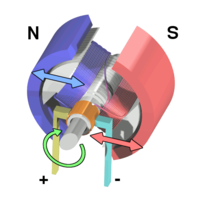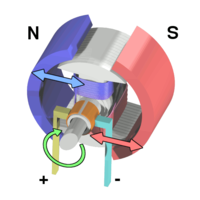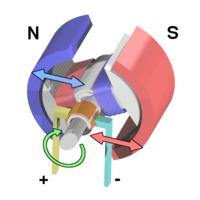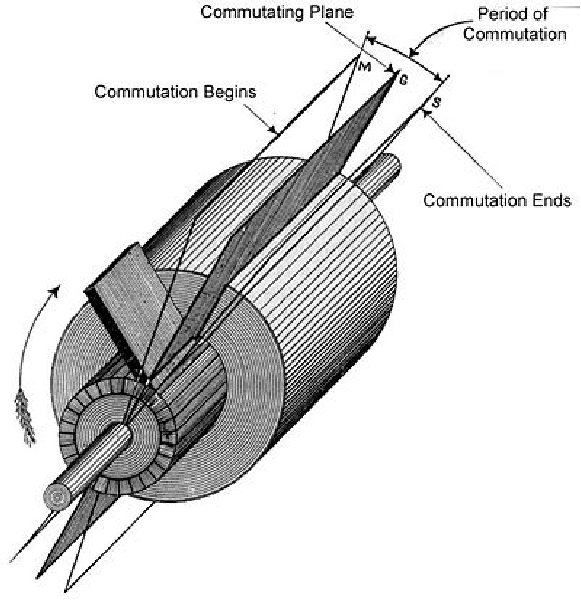
- •Memorize the words and word combinations and their equivalents.
- •Find the words and combinations of words in the text and translate the sentences containing them.
- •Read and translate the text.
- •Translate the word combinations from the text:
- •Point out the sentences in the text in which the word “to make” should be translated as “примушувати”.
- •Answer the questions.
- •Find the sentences in the text telling you about two problems facing the simple two pole dc motor. Text b Compensation for stator field distortion
- •Make sure that you know these words and word combinations.
- •Read and translate the text.
- •Answer the questions.
- •Text c Dynamo Design Variations
- •Read and memorise the words and word combinations.
- •Permanent magnet motor – двигун з постійним магнитом
- •Read and translate the text.
- •Answer the questions.
- •Listen to the words and word combinations from the text. Pay attention to their meaning.
- •Memorize the words and word combinations and their equivalents.
- •Read and translate the text.
- •Match the words and word combinations (a-e) to the sentences (1-5)
- •Answer the questions to the text
- •Say if the statement to the text is true or false
- •Translate the sentences paying attention to Indefinite Tenses in Active and Passive. Correct the mistakes in the sentences.
- •Text b Basic construction
- •Listen to the words and word combinations from the text. Pay attention to their meaning.
- •Memorize the words and word combinations and their equivalents
- •Read and translate the text
- •Match the words and word combinations (a-e) to the sentences (1-5)
- •Answer the questions to the text
- •Say if the statements to the text are true or false
- •Translate the sentences paying attention to Indefinite Tenses in Active and Passive. Correct the mistakes in the sentences.
- •Text c Principles of operation
- •Listen to the words and word combinations from the text. Pay attention to their meaning.
- •Find the words and combinations of words in the text and translate the sentences containing them.
- •Memorize the words and word combinations and their equivalents.
- •Read and translate the text
- •Match the words and word combinations (a-f) to the sentences (1-6)
- •Answer the questions to the text
- •Define the functions of Participle I and Participle II in the following sentences
- •Say, which of the sentences are in the Active and which are in the Passive Voice
- •Translate the sentences paying attention to the Sequence of Tenses
- •Translate the following Conditional sentences
- •Transformer Text a
- •Read and memorize words and word-combination
- •Make sure that you know these words and word combinations.
- •Read and translate the text.
- •Math the following English words with the Ukrainian ones.
- •Find English equivalents to the words:
- •Translate the word combinations from the text:
- •Answer the questions to the text.
- •Text b Operation at different frequencies
- •Read and memorize the words and word-combinations
- •Be sure that you know these words
- •Read and translate the text.
- •Text c Limitations
- •Make sure that you know these words and word combinations.
- •Read and translate the text.
- •Find the equivalents to the following.
- •Text d Construction
- •Read and memorise the words and word combinations
- •Read and translate the text. Cores
- •Find the equivalents to the folloving English words:
- •Point out English equivalents to the words:
- •Translate the word combinations.
- •Answer the questions.
- •Read the passage about steel cores. Retell it. Text e Windings
- •Listen to the words and word combinations from the text and memorize them.
- •Read and translate the text.
- •Match the English words and word combinations with the Ukrainian ones.
- •Insulation of windings
- •Text g Shielding
- •Supplement Speed control
- •Dc motor starters
- •Shielding
- •Autotransformers
- •Voltage transformers
- •Pulse transformers
- •3 Phase electrical power Transformer
- •3 Phase Transformer Delta and Wye Connections
- •Перелік скорочень
МІНІСТЕРСТВО ОСВІТИ І НАУКИ УКРАЇНИ
Запорізький національний технічний університет
Методичні вказівки
до практичних занять з англійської мови для студентів спеціальності “Електромеханічне обладнання енергоємних підприємств” за напрямками електромеханіка, електротехніка, енергетика.
Ч.I
2008 р.
Методичні вказівки до практичних занять з англійської мови для студентів спеціальності “Електромеханічне обладнання енергоємних підприємств” за напрямками електромеханіка, електротехніка, енергетика. Ч.I / Укл.: В.Г. Кузьменко – Запоріжжя: ЗНТУ, 2008.- 72 с.
Укладач: В.Г. Кузьменко, ст. викладач
Рецензент: Т.О. Сокол, ст. викладач
Експерт: О.М. Расальський., зав. кафедри ЕА
Відповідальний
за випуск: В.Г. Кузьменко, ст. викладач
Затверджено
на засіданні кафедри іноземних мов
протокол № 6 від 30.12.2007 р.
Contents
Electrical Machines……………………………………………... 4
Brushed DC Electric Motor…………………………………..... 4
3-phase AC induction motor.………………………………...... 15
Transformer..………………………………………………....... 33
Supplement………………………………………………......... 57
Перелік скорочень…………………………………………….. 72
Electrical Machines
Brushed DC Electric Motor
Text A
-
Listen to the words and word combinations from the text. Pay attention to their meaning.
brush – щітка
motor – двигун
DC – постійний струм
brushed DC motor – двигун постійного струму з щітковим колектором
commutate – комутувати, перемикати
to run – працювати, експлуватувати
power source – джерело живлення
pole – полюс
coil – обмотка
to power – живити, пропускати струм
magnet – магніт
magnetic field – магнітне поле
to generate – генерувати
armature – якір
to cause – викликати, заставляти
to rotate – обертати(сь)
to align – вирівнювати
commutator – колектор, комутатор, перемикач
to reverse – змінювати напрямок на зворотній
current – струм
to wind – намотувати
core – сердечник, стержень
positive – позитивний
to act – діяти
turning – обертання
direction – напрямок
cycle – період, цикл, оберт
plane – площина.
-
Memorize the words and word combinations and their equivalents.
torque – обертаючий момент, пусковий момент
rotor – ротор
to displace – переміщати(ся), зміщувати(ся)
degree – градус
stator – статор
to start – запускати
inertia – інерція
commutator brush – колекторна щітка
commutator plates – пластини комутатора
short-circuit – коротке замикання, ланцюг короткого замикання
consume – споживати
harmful – шкідливий, небезпечний
watt – ватт
power output – вихідна енергія
overheating – перегрів
damage – пошкодження
welding – зварка
to flow – текти, протікати
shaft – вал
generator – генератор
voltage – напруга.
-
Find the words and combinations of words in the text and translate the sentences containing them.
to spin – обертатись
to apply – прикладати, застосовувати
electrical load – електричне навантаження
resistance – опір
terminal – клема, зажим, вивід
voltage drop – падіння напруги
due to – завдяки
winding – обмотка
equation – рівняння
mechanical power – механічна енергія
speed – швидкість
to reduce – зменшувати(сь)
to slow – сповільнювати(сь)
to draw – витікати, протікати
to excite – збуджувати(сь)
revolution – оберт
ampere – ампер
to help on – сприяти
to absorb – поглинати
friction – тертя
to drive – приводити в дію
commutating plane – площина комутації.
-
. Pay attention to the translation of the following.
internal – внутрішній
external – зовнішній
to result in (smth) – приводити до (чогось), мати своїм результатом (щось)
to result from (smth) – в результаті (чого-небудь), бути наслідком (чого-небудь)
to increase – збільшувати(сь), зростати
to decrease – зменшувати(сь)
electromotive force (EMF) =
= electromotive power – електрорушійна сила
counter electromotive force = counter - EMF (CEMF) = backward-flowing electromotive force = back EMF – протиелектрорушійна сила
i.e.= that is – тобто
per – за
to be refferred to as – називатись.
-
Read and translate the text.
A brushed DC motor is an internally commutated electric motor designed to be run from a DC power source.
The following graphics illustrate a two pole DC motor.
Simple Two Pole DC Motor Rotation
-



A simple DC electric motor. When the coil is powered, a magnetic field is generated around the armature. The left side of the armature is pushed away from the left magnet and drawn toward the right, causing rotation.
The armature continues to rotate.
When the armature becomes horizontally aligned, the commutator reverses the direction of current through the coil, reversing the magnetic field. The process then repeats.
When a current passes through the coil wound around a soft iron core, the side of the positive pole is acted upon by an upwards force, while the other side is acted upon by a downward force. According to Fleming's left hand rule, the forces cause a turning effect on the coil, making it rotate. To make the motor rotate in a constant direction, "direct current" commutators make the current reverse in direction every half a cycle thus causing the motor to rotate in the same direction.
The problem facing the motor shown above, is when the plane of the coil is parallel to the magnetic field; i.e. the torque is ZERO-when the rotor poles are displaced 90 degree from the stator poles. The motor would not be able to start in this position, but the coil can continue to rotate by inertia.
There is a secondary problem with this simple two-pole design; at the zero-torque position, both commutator brushes are touching across both commutator plates, resulting in a short-circuit that uselessly consumes power without producing any motion. In a low-current battery-powered demonstration this short-circuiting is generally not considered harmful, but if a two-pole motor were designed to do actual work with several hundred watts of power output, this shorting could result in severe commutator overheating, brush damage, and potential welding of the metallic brushes to the commutator.
Unlike the demonstration motor, above, DC motors are commonly designed with more than two poles, are able to start at any position, and do not have any position where current can flow without producing electromotive power.
If the shaft of a DC motor is turned by an external force, the motor will act like a generator and produce an Electromotive force (EMF). During normal operation, the spinning of the motor produces a voltage, known as the counter-EMF (CEMF) or back EMF, because it opposes the applied voltage on the motor. This is the same EMF that is produced when the motor is used as a generator (for example when an electrical load (resistance) is placed across the terminals of the motor and the motor shaft is driven with an external torque). Therefore, the voltage drop across a motor consists of the voltage drop, due to this CEMF, and the parasitic voltage drop resulting from the internal resistance of the armature's windings. The current through a motor is given by the following equation:
I = (Vapplied − Vcemf) / Rarmature
The mechanical power produced by the motor is given by:
P = I * (Vcemf)
As an unloaded DC motor spins, it generates a backwards-flowing electromotive force that resists the current being applied to the motor. The current flow through the motor drops as the rotational speed increases, and a free-spinning motor has very little current flow. It is only when a load is applied to the motor that slows the rotor that the current draw through the motor increases. In an experiment of this kind made on a motor with separately excited magnets, the following figures were obtained:
|
Revolutions per minute |
0 |
50 |
100 |
160 |
180 |
195 |
|
Amperes |
20 |
16.2 |
12.2 |
7.8 |
6.1 |
5.1 |
Apparantly, if the motor had been helped on to run at 261.5 revolutions per minute, the current would have been reduced to zero. In the last result obtained, the current of 5.1 amperes was absorbed in driving the armature against its own friction at the speed of 195 revolutions per minute."
In a DC motor, the contact point of where a pair of brushes touch the commutator is referred to as the commutating plane. In this diagram the commutating plane is shown for just one of the brushes.
 Commutating
plain for just one of the brushes
Commutating
plain for just one of the brushes
